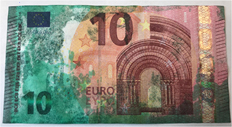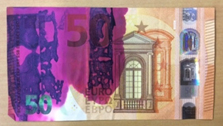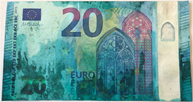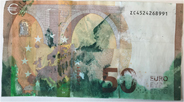
Euro banknotes are a tangible symbol of the European Union, and some 347 million people in 20 countries now use the euro.
General features
The euro banknotes that are legal tender throughout the euro area comprise the following denominations: €5, €10, €20, €50, €100, €200 and €500; the latter was only printed in the first series.
The euro banknotes were designed by Robert Kalina from the Austrian central bank (Oesterreichische Nationalbank). He won the Europe-wide design competition held in 1996.
Each euro banknote depicts a European architectural style. In ascending order of denomination the styles represented are: Classical, Romanesque, Gothic, Renaissance, Baroque and rococo, the Age of iron and glass, and Modern 20th century architecture.
In addition, the windows and gateways symbolize the European spirit of openness and cooperation. The 12 stars of the European Union (EU) represent the dynamism and harmony of contemporary Europe. The bridges on the back of the notes symbolize communication between the people of Europe and between Europe and the rest of the world.
The notes also carry:
- the name of the currency - euro - in both the Latin (EURO) and the Greek (EYPΩ) alphabets
- the EU flag
- in the first series, the initials of the European Central Bank in five linguistic variants - BCE, ECB, EZB, EKT and EKP - covering the 11 EU official languages at the time of the introduction of the euro; in the second series there are the initials in 9 linguistic variants. The symbol © indicates copyright protection.
Security features
Euro banknotes incorporate various security features to help users recognize a genuine banknote at a glance. It only takes a few seconds to check a banknote by feeling it, looking at it and tilting it.
Special printing processes make it possible to feel the raised print on the banknotes.
On the front and back of genuine banknotes, it is possible to see the watermark, the security thread and the see-through number. By tilting the banknote, on the front it is possible to see the shifting image on the hologram.
On the back, it is possible to see the glossy stripe on the lower denomination banknotes (€5, €10, and €20) or the colour-changing number on the remaining notes.
For more information about checks, click on the link to the ECB website.
Signature
Under Article 1 of ECB Decision ECB/2003/4 on the denominations, specifications, reproduction, replacement and withdrawal of euro banknotes, the notes bear the signature of the President of the ECB.
At present, euro banknotes can be found in circulation with the signature of Christine Lagarde, President of the European Central Bank or one of her predecessors, namely Mario Draghi, Claude Trichet and Willem F. Duisenberg. These banknotes are all equally valid.
Reproductions and replacements
The regulations for reproducing and replacing euro banknotes set out the criteria for reproduction so that they cannot be mistaken for genuine banknotes. There are also guidelines for replacing banknotes that have suffered minor intentional damage or those presented for replacement by a bona fide customer.
These regulations, published in the Official Journal of the European Union, are available on the ECB website.
The second series of euro banknotes
On 2 May 2013, the Eurosystem introduced its second series of euro banknotes, dedicated to Europa, a figure from Greek mythology and chosen because of its link with the continent of Europe. The portrait of Europa shown on the banknotes (in the watermark and in the silvery strip with the hologram) was taken from a vase kept in the Louvre museum in Paris.
The six banknotes in this series, the €5, €10, €20, €50, €100 and €200 notes, were issued in 2013, 2014, 2015, 2017 and 2019 respectively (the €100 and €200 notes were issued together).
On 4 May 2016, the ECB's Governing Council decided that the €500 banknote would not be included in the Europa series and that it would no longer be issued after the end of 2018.
The Eurosystem's central banks continued to distribute €500 banknotes up until 26 January 2019. To ensure a smooth transition and for logistical reasons, the central banks of Germany (Deutsche Bundesbank) and Austria (Oesterreichische Nationalbank) continued to issue €500 banknotes up until 26 April 2019.
€500 banknotes in any case continue to be legal tender and will be usable for payments and as a store of value.
€500 banknotes, like all the other euro banknotes, will always retain their value and can be exchanged at the national central banks of the Eurosystem for an unlimited period of time.
Professional operators (banks, service firms, currency exchange offices and so on) can recirculate €500 banknotes.
The Bank of Italy provides assistance and support to update manufacturers and owners of banknote handling machines.
Worn, damaged or mutilated banknotes
Euro banknotes, which are made of pure cotton paper, inevitably deteriorate with use.
In order to ensure that the banknotes in circulation retain a high level of quality, the Bank of Italy regularly withdraws worn banknotes, replacing them with new ones.
Besides the normal process of deterioration with use, banknotes can be damaged or mutilated for various reasons (e.g. flood/fire damage, chemical contamination, torn notes, accidental washing).
A banknote is said to be damaged when it is dirty, stained or discoloured as a result of accidental events.
A banknote is said to be mutilated when part of it is missing. As a general rule, a mutilated banknote can be exchanged if the part presented for replacement is more than 50 per cent of the original note or, otherwise, if it can be proved that the missing part was destroyed accidentally.
Mutilated banknotes should be placed between transparent or plasticized sheets, preserving even the smallest fragments so as to avoid any further damage. Sticking tape and/or glue should not be used.
What to do if you have damaged or mutilated notes
Persons who have damaged or mutilated notes can ask to have them exchanged for new notes at any branch of the Bank of Italy. The notes will be examined and, if they meet the exchange requirements, immediately exchanged for new ones.
Damaged and mutilated notes that cannot be exchanged immediately at a branch, because there are doubts about their being exchangeable, are sent to the Bank's Head Office, where they are examined by a special committee that decides whether they are exchangeable.
Notes that the committee judges to be exchangeable are kept at the Bank's Head Office for destruction and the persons who submitted them are reimbursed for their value at the branch that sent them for examination.
Notes that the committee judges not to be exchangeable are returned to the persons who submitted them, in the case of mutilated notes to allow them to make a new request for exchange if the missing parts are found.
If the state the notes are in or the place they come from suggest they could be infectious, the person submitting them may be asked to produce a certificate indicating that they have been sterilized or disinfected.
Reimbursement of damaged or mutilated notes
Generally, notes are reimbursed free of charge. A fee is only charged if the applicants have requested the exchange of euro banknotes accidentally damaged by anti-theft devices.
Banknotes that have been damaged or mutilated intentionally
Generally, intentionally damaged or mutilated banknotes are not replaced but instead are withheld with no reimbursement.
However, those banknotes are replaced if the applicant is in good faith and/or if there is only a modest degree of damage (small phrases, numbers or annotations written on the banknote).
Banknotes that have been damaged as the result of a criminal act
Banknotes damaged or mutilated following a criminal act are sent to the Provincial Headquarters of the Guardia di Finanza.
If the competent authority returns the banknotes because there is no criminal element to the damage, the banknotes are treated as ordinarily damaged or mutilated banknotes and therefore reimbursed or returned to the applicant following the procedure described above.
Ink stained banknotes
If you receive banknotes like these ones, do not accept them, as they are probably stolen banknotes.
 |
 |
These banknotes were stained with a security ink by anti-theft devices, also known as Intelligent Banknote Neutralisation Systems (IBNS), when criminals opened a protected cash container, used either in an ATM or for transportation. These systems make stolen banknotes unusable, thus reducing the risk for retailers, banks and other professional cash handlers of becoming the victims of crime.
How do IBNS work?
When a banknote is stained by an intelligent banknote neutralisation system (IBNS), the security ink soaks into the banknote and leaves traces that are normally more pronounced on the edges of the banknote, as the ink usually flows from the edges towards the centre of the banknotes. The colours of the most commonly used security inks are violet, green, blue, red or black.
Sometimes criminals try to wash the banknotes in order to remove the ink and the chemicals used in this process may change the colour of the security ink. As a result, the banknotes' original colours could also be altered, and some security features may be damaged, or may even disappear.
Glue is another means used in anti-theft devices for the protection of cash. Glue fuses all banknotes inside an ATM cassette together into a solid brick. If anyone tries to peel off single banknotes, they will tear into pieces.
Banknotes that have probably been stolen and which should not be accepted:
 |
 |
 |
Does that mean all ink-stained banknotes are stolen?
No. If there are one or two small marks on the banknote and the edges are intact, then the marks are most likely accidental. In addition, very light stains are not usually from an anti-theft device. These banknotes are not likely to have been stolen and can be accepted.
 |
 |
 |
Banknotes without IBNS ink-stains
What if someone gives me a clearly IBNS ink-stained banknote?
- Refuse to accept it and simply ask for another one. The obvious ink-staining of the banknote leads you to believe that the person offering you the banknote is not the rightful owner.
- You should also refuse bleached or discoloured banknotes, as criminals have most likely tried to remove the IBNS ink-stains by washing or bleaching.
- If you have accepted an IBNS-ink stained banknote, you should take it to your local bank or the national central bank, and give them information about the origin of the banknote. Your bank will submit the note to the Bank of Italy, which in turn may involve the police, because the banknote could be useful for further criminal investigations. The Bank of Italy will reimburse banknotes if the competent authority returns them in the absence of demonstrable criminal intent.
ECB official line
The ECB has adopted replacement rules for damaged or mutilated (e.g. partially burnt, cut, discoloured or decomposed) banknotes, which are uniformly applied by all national central banks of the Eurosystem. The Decision of the European Central Bank of 19 April 2013 on the denominations, specifications, reproduction, exchange and withdrawal of euro banknotes (https://www.ecb.europa.eu/ecb/legal/pdf/l_11820130430en00370042.pdf), stipulates in Article 3.2 that euro banknotes stained by anti-theft devices must only be exchanged by the NCBs with the original banknote owner who is victim of the criminal activity, or attempted criminal activity, which led to the staining of the banknotes. Credit institutions receiving such notes from their customers must ask for written information on the origin of the notes and hand them over to the NCB.
Briquettes

The Bank of Italy, like other central banks, sets aside a portion of its shredded banknotes to be packaged in small cylinders or bricks covered in cellophane, called 'briquettes'. These objects have no intrinsic value and are usually given as gifts at institutional events.
The Bank of Italy does not sell these briquettes, even over the Internet, and is not affiliated with anyone who does; it cannot stop their sale by third parties.
Statistics on banknote issuance in Italy
The Bank of Italy publishes statistics on the domestic issuance of banknotes: amounts withdrawn, amounts deposited, and 'net issuance' (the difference between withdrawals and deposits) at branches, broken down by denomination.
Exchange of lira notes and coins
With the introduction of euro notes and coins, those denominated in lire ceased to be legal tender at the end of the dual circulation period on 28 February 2002.
Pursuant to Article 26 of Decree Law 201/2011, published in Gazzetta Ufficiale no. 284 of 6 December 2011, "by way of derogation from Article 3, paragraphs 1 and 1 bis, of Law 96/1997 and Article 52-ter, paragraphs 1 and 1 bis, of Legislative Decree 213/1998, lira banknotes, notes and coins still in circulation shall lapse and be assigned to the Treasury with immediate effect".
Accordingly, from 7 December 2011 all lira banknotes and coins may no longer be exchanged. Italy's Constitutional Court has declared this provision unlawful.
Further information on the exchange of lira banknotes and coins is available in the section 'Services for the public/exchange of banknotes and coins'.
Annexes
- Denominationpdf 92.5 KB Publish date::17 September 2007
- Security features (external link) Various security features have been incorporated into the euro banknotes. They will help you to recognise a genuine banknote at a glance
The second series of euro banknotes - €100 and €200
- The new €100 and €200 banknotespdf 6.2 MB Publish date::27 September 2018
- ECB unveils new €100 and €200 banknotespdf 28.5 KB Publish date::17 September 2018
- The new €100 and €200 banknotes - Photo gallery (external link)
- The new €100 and €200 banknotes - Video gallery (external link)
- See the banknotes in 3D (external link)
The second series of euro banknotes - €50
- Press kit: Discover the new €50 banknotepdf 5.2 MB Publish date::05 July 2016
- Download the video “The new €50 banknote”zip 50.2 MB Publish date::07 February 2017
- The new €50 banknote - video(Video)
- ECB unveils new €50 banknotepdf 58.4 KB Publish date::05 July 2016
The second series of euro banknotes - €20
- The new €20 banknote - leafletpdf 2.9 MB Publish date::17 April 2015
- The new €20 banknote - security featurespdf 422.2 KB Publish date::17 April 2015
- The Europa series - posterpdf 964.9 KB Publish date::17 April 2015
The second series of euro banknotes - €10
- Press kit: Discover the new €10 banknotepdf 4.8 MB Publish date::13 January 2014
- New €10 banknote unveiled in Frankfurt todaypdf 36.4 KB Publish date::13 January 2014
- Eurosystem will introduce new €10 banknote in 2014 with support from partnership programmepdf 26.7 KB Publish date::26 November 2013
- Discover the security features of the new €10 banknote (external link)
The second series of euro banknotes - €5
- Press kit: Discover the new €5 banknotepdf 4.1 MB Publish date::10 January 2013
- Press kit on the Europa series: the second series of euro banknotespdf 6.3 MB Publish date::10 January 2013
- Europa series €5 banknote to be issued as of 2 May 2013pdf 25.8 KB Publish date::30 April 2013
- Discover the security features of the new €5 banknote (external link)
Reference regulations
- Guideline of the European Central Bank of 20 March 2003 (external link) Enforcement of measures to counter non-compliant reproductions of euro banknotes and on the exchange and withdrawal of euro banknotes
- Decision of the European Central Bank of 19 April 2013 (2013/10) (external link) Denominations, specifications, reproduction, exchange and withdrawal of euro banknotes
- Guideline of the European Central Bank of 19 April 2013 (external link) Amending Guideline ECB/2003/5 on the enforcement of measures to counter non-compliant reproductions of euro banknotes and on the exchange and withdrawal of euro banknotes (ECB/2013/11)
STATISTICS
- Statistics on banknote issuance in Italypdf 110.7 KB Publish date::16 February 2016
- Latest figures on euro banknotes and coins (external link) Statistics updated around the 14th working day of each month
Related Topics
 Exchange of banknotes and coins
Exchange of banknotes and coins
The service will replace damaged euro notes and coins and change euro notes and coins for others of different denominations.




